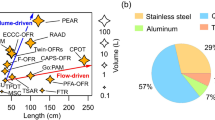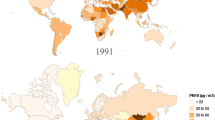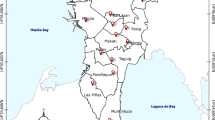Abstract
The impact of biomass combustion on atmospheric particulate matter was investigated at Central and Northern European urban background sites (Duisburg, Prague, Amsterdam, Helsinki) in 2002–2003. In Helsinki, additional 4-week sampling campaigns were carried out during the four seasons in 2003–2004. During campaigns fine particles (PM2.5) and size-segregated samples were collected with a virtual impactor and a ten-stage Berner low-pressure impactor, respectively. From the aerosol samples monosaccharide anhydrides (MA) were determined as source specific tracers for biomass combustion. MA comprised 0.29–6.3% of the PM2.5 mass and 0.45–7.3% of its organic carbon content. According to size-segregated samples, the mean diameter of a prominent MA mode coincided with the accumulation mode of particulate mass, except for Prague where the MA mode appeared in a slightly smaller particle size range than the mass. The estimated contribution of biomass combustion to the OC and PM2.5 mass concentration was the highest in wintertime Prague, 79% and 37%, respectively. It seems that, in addition to traffic in densely populated areas, incomplete biomass combustion with current heating appliances can be a major source of particulate pollution both at local and regional scales.





Similar content being viewed by others
References
Artaxo, P., & Hansson, H.-C. (1995). Size distribution of biogenic aerosol particles from the Amazon basin. Atmospheric Environment, 29, 393–402.
Berner, A., & Lürzer, C. (1979). Mass size distributions of traffic aerosols at Vienna. Journal of Physical Chemistry, 84, 2079–2083.
Birch, M. E., & Cary, R. A. (1996). Elemental carbon-based method for monitoring occupational exposures to particulate diesel exhaust. Aerosol Science and Technology, 25, 221–241.
Boman, B. C., Forsberg, A. B., & Järvholm, B. G. (2003). Adverse health effects from ambient air pollution in relation to residential wood combustion in modern society. Scandinavian Journal of Work, Environment & Health, 29, 251–260.
Brewer, P. G. (1975). Minor elements in sea water. In R. Chester (Ed.) Chemical oceonography (vol. 1, (pp. 417–425)). San Diego, California: Academic.
Brook, J. R., Dann, T. F., & Burnett, R. T. (1997). The relationship among TSP, PM10, PM2.5, and inorganic constituents of atmospheric particulate matter at multiple Canadian locations. Journal of the Air & Waste Management Association, 47, 2–19.
Chebbi, A., & Carlier, P. (1996). Carboxylic acids in the troposphere, occurrence, sources, and sinks: A review. Atmospheric Environment, 24, 4233–4249.
Dye, C., & Yttri, K. E. (2005). Determination of monosaccharide anhydrides in atmospheric aerosols by use of high-performance liquid chromatography combined with high-resolution mass spectrometry. Analytical Chemistry, 77, 1853–1858.
Echalar, F., Gaudichet, A., Cachier, H., & Artaxo, P. (1995). Aerosol emissions by tropical forest and savanna biomass burning: Characteristic trace elements and fluxes. Geophysical Research Letters, 22, 3039–3042.
European Commission (2005). Commission staff working paper SEC (2005) 1133—Annex to the Communication on Thematic Strategy on Air Pollution and the Directive on “Ambient Air Quality and Cleaner Air for Europe”. European Commission: Brussels. Retrieved from http://www.ec.europa.eu/environment/air/cafe/pdf/ia_report_en050921_final.pdf.
Fine, P. M., Cass, G. R., & Simoneit, B. R. T. (2001). Chemical characterization of fine particle emissions from fireplace combustion of woods grown in the Northeastern United States. Environmental Science & Technology, 35, 2665–2675.
Fine, P. M., Cass, G. R., & Simoneit, B. R. T. (2002). Chemical characterization of fine particle emissions from fireplace combustion of woods grown in the Southern United States. Environmental Science & Technology, 36, 1442–1451.
Fine, P. M., Cass, G. R., & Simoneit, B. R. T. (2004). Chemical characterization of fine particle emissions from the fireplace combustion of wood types grown in the Midwestern and Western United States. Environmental Engineering Science, 21, 387–409.
Fraser, M. P., & Lakshmanan, K. (2000). Using levoglucosan as a molecular marker for the long-range transport of biomass combustion aerosols. Environmental Science & Technology, 34, 4560–4564.
Glasius, M., Ketzel, M., Wåhlin, P., Jensen, B., Mønster, J., Berkowicz, R., et al. (2006). Impact of wood combustion on particle levels in residential area in Denmark. Atmospheric Environment, 40, 7115–7124.
Hays, M. D., Fine, P. M., Geron, C. D., Kleeman, M. J., & Gullett, B. K. (2005). Open burning of agricultural biomass: Physical and chemical properties of particle-phase emissions. Atmospheric Environment, 39, 6747–6764.
Happo, M. S., Salonen, R. O., Hälinen, A. I., Jalava, P. I., Pennanen, A. S., Kosma, V.-M., et al. (2007). Dose and time-dependency of inflammatory responses in the mouse lung to urban air coarse, fine and ultrafine particles from six European cities. Inhalation Toxicology, 19, 227–246.
Hedberg, E., Johansson, C., Johansson, L., Swietlicki, E., & Brorström-Lundén, E. (2006). Is levoglucosan a suitable quantitative tracer for wood burning? Comparison with receptor modeling on trace elements in Lycksele, Sweden. Journal of the Air & Waste Management Association, 56, 1669–1678.
Jaffrezo, J.-L., Davidson, C. I., Kuhns, H. D., Bergin, M. H., Hillamo, R., Maenhaut, W., et al. (1998). Biomass burning signatures in the atmosphere of central Greenland. Journal of Geophysical Research, D23, 31,067–31,078.
Jalava, P. I., Salonen, R. O., Pennanen, A. S., Sillanpää, M., Hälinen, A. I., Happo, M. S., et al. (2007). Heterogeneities in inflammatory and cytotoxic responses of RAW 264.7 macrophage cell line to urban air coarse, fine and ultrafine particles from six European sampling campaigns. Inhalation Toxicology, 19, 213–225.
Karppinen, A., Härkönen, J., Kukkonen, J., Aarnio, P., & Koskentalo, T. (2004). Statistical model for assessing the portion of fine particulate matter transported regionally and long range to urban air. Scandinavian Journal of Work, Environment & Health, 30(suppl.2), 47–53.
Kukkonen, J., Pohjola, M., Sokhi, R. S., Luhana, L., Kitwiroon, N., Fragkou, L., et al. (2005). Analysis and evaluation of selected local-scale PM10 air pollution episodes in four European cities: Helsinki, London, Milan and Oslo. Atmospheric Environment, 39, 2759–2773.
Legrand, M., & Puxbaum, H. (2007). Summary of the CARBOSOL project: Present and retrospective state of organic versus inorganic aerosol over Europe. Journal of Geophysical Research, 112, D23S01.
Lighty, J. S., Veranth, J. M., & Sarofim, A. F. (2000). Combustion aerosols: Factors governing their size and composition and implications to human health. Journal of the Air & Waste Management Association, 50, 1565–1618.
Loo, B. W., & Cork, C. P. (1988). Development of high efficiency virtual impactor. Aerosol Science and Technology, 9, 167–170.
Naeher, L. P., Brauer, M., Lipsett, M., Zelikoff, J. T., Simpson, C. D., Koenig, J. Q., et al. (2007). Woodsmoke health effects: A review. Inhalation Toxicology, 19, 67–106.
Nolte, C. G., Schauer, J. J., Cass, G. R., & Simoneit, B. R. T. (2001). Highly polar organic compounds present in wood smoke and in the ambient atmosphere. Environmental Science & Technology, 35, 1912–1919.
Nunes, T. V., & Pio, C. A. (1993). Carbonaceous aerosols in industrial and coastal atmospheres. Atmospheric Environment, 27A, 1339–1346.
Oros, D. R., bin Abas, M. R., Omar, N. Y. M. J., Rahman, N. A. R., & Simoneit, B. R. T. (2006). Identification and emission factors of molecular tracers in organic aerosols from biomass burning Part 3. Grasses. Applied Geochemistry, 21, 919–940.
Oros, D. R., & Simoneit, B. R. T. (2001a). Identification and emission factors of molecular tracers in organic aerosols from biomass burning. Part 1. Temperate climate conifers. Applied Geochemistry, 16, 1513–1544.
Oros, D. R., & Simoneit, B. R. T. (2001b). Identification and emission factors of molecular tracers in organic aerosols from biomass burning. Part 2. Deciduous trees. Applied Geochemistry, 16, 1545–1565.
Pakkanen, T. A., Kerminen, V.-M., Korhonen, C. H., Hillamo, R. E., Aarnio, P., Koskentalo, T., et al. (2001a). Use of atmospheric elemental size distributions in estimating aerosol sources in Helsinki area. Atmospheric Environment, 35, 5537–5551.
Pakkanen, T. A., Loukkola, K., Korhonen, C. H., Aurela, M., Mäkelä, T., Hillamo, R., et al. (2001b). Sources and chemical composition of atmospheric fine and coarse particles in the Helsinki area. Atmospheric Environment, 35, 5381–5391.
Pósfai, M., Gelencsér, A., Simonics, R., Arató, K., Li, J., Hobbs, P. V., et al. (2004). Atmospheric tar balls: Particles from biomass and biofuel burning. Journal of Geophysical Research, 109, D06213.
Purvis, C. R., McCrillis, R. C., & Kariher, P. H. (2000). Fine particulate matter (PM) and organic speciation of fireplace emissions. Environmental Science & Technology, 34, 1653–1658.
Puxbaum, H., Caseiro, A., Sánchez-Ochos, A., Kasper-Giebl, A., Claeys, M., Legrand, M., et al. (2007). Levoglucosan levels at background sites in Europe for assessing the impact of biomass combustion on the European aerosol background. Journal of Geophysical Research, 112, D23S05.
Rogge, W. F., Mazurek, M. A., Hildemann, L. M., Cass, G. R., & Simoneit, B. R. T. (1993). Quantification of urban organic aerosols at molecular level: Identification, abundance and seasonal variation. Atmospheric Environment, 27A, 1309–1330.
Schauer, J. J., Kleeman, M. J., Cass, G. R., & Simoneit, B. R. T. (2001). Measurement of emissions from air pollution sources. 3. C1–C29 organic compounds from fireplace combustion of wood. Environmental Science & Technology, 35, 1716–1728.
Schauer, J. J., Rogge, W. F., Hildemann, L. M., Mazurek, M. A., Cass, G. R., & Simoneit, B. R. T. (1996). Source apportionment of airborne particulate matter using organic compounds as tracers. Atmospheric Environment, 22, 3837–3855.
Sillanpää, M., Frey, A., Hillamo, R., Pennanen, A., & Salonen, R. O. (2005). Organic, elemental and inorganic carbon in particulate matter of six urban environments in Europe. Atmospheric Chemistry and Physics, 5, 2869–2879.
Sillanpää, M., Hillamo, R., Saarikoski, S., Frey, A., Pennanen, A., Makkonen, U., et al. (2006). Chemical composition and mass closure of particulate matter at six urban sites in Europe. Atmospheric Environment, 40, S212–S223.
Simoneit, B. R. T. (2002). Biomass burning—A review of organic tracers for smoke from incomplete combustion. Applied Geochemistry, 17, 129–162.
Simoneit, B. R. T., Schauer, J. J., Nolte, C. G., Oros, D. R., Elias, V. O., Fraser, M. P., et al. (1999). Levoglucosan, a tracer for cellulose in biomass burning and atmospheric particles. Atmospheric Environment, 33, 173–182.
Szidat, S., Jenk, T. M., Synal, H.-A., Kalberer, M., Wacker, L., Hajdas, I., et al. (2006). Contributions of fossil fuel, biomass-surning, and biogenic emissions to carbonaceous aerosols in Zurich as traced by 14C. Journal of Geophysical Research, 111, D07206.
Teinilä, K., Kerminen, V.-M., & Hillamo, R. (2000). A study of size-segregated aerosol chemistry in the Antarctic atmosphere. Journal of Geophysical Research, 105(D3), 3893–3904.
Tervahattu, H., Hongisto, M., Aarnio, P., Kupiainen, K., & Sillanpää, M. (2004). Composition and origins of aerosol during a high PM10 episode in Finland. Boreal Environmental Research, 9, 335–345.
Yttri, K. E., Dye, C., & Kiss, G. (2007). Ambient aerosol concentrations of sugars and sugar-alcohols at four different sites in Norway. Atmospheric Chemistry and Physics, 7, 4267–4279.
Yttri, K. E., Dye, C., Slørdal, L. H., & Braathen, O.-A. (2005). Quantification of monosaccharide anhydrides by liquid chromatography combined with mass spectrometry: Application to aerosol samples from an urban and a suburban site influenced by small-scale wood burning. Journal of the Air & Waste Management Association, 55, 1169–1177.
Zdráhal, Z., Oliveira, J., Vermeylen, R., Claeys, M., & Maenhaut, W. (2002). Improved method for quantifying levoglucosan and related monosaccharide anhydrides in atmospheric aerosols and application to samples from urban and tropical locations. Environmental Science & Technology, 36, 747–753.
Zrostlíková, J., Hajšlová, J., Poustka, J., & Begany, P. (2002). Alternative calibration approaches to compensate the effect of co-extracted matrix components in liquid chromatography-electrospray ionization tandem mass spectrometry analysis of pesticide residues in plant materials. Journal of Chromatography A, 973, 13–26.
Acknowledgement
This study was conducted within the framework of the project ‘Chemical and biological characterization of ambient air coarse, fine, and ultrafine particles for human health risk assessment in Europe’ (PAMCHAR) co-ordinated by the National Public Health Institute of Finland (http://www.pamchar.org/). The financial support of the EC-FP5 Quality of Life and Management of Living Resources Programme (Contract QLK4-CT-2001–00423), the Academy of Finland (FINE-contracts 201701 and 201131), and the Centre of Excellence Programme 2002–2007 of the Academy of Finland (Contract 53307) and the National Technology Fund (TEKES, Contract 40715/01) is also highly appreciated. The authors are grateful to the teams of T. Kuhlbusch (Institute für Energie- und Umwelttechnik, Duisburg, DE), M. Branis (Charles University in Prague, CZ), B. Brunekreef (University of Utrecht, NL), J. Sunyer (Institut Minicipal d’Investigaci Médica, Barcelona, ES) and K. Katsouyanni and I. Kavouras (National and Kapodistrian University of Athens and National Observatory of Athens, GR) for conducting the sampling campaigns. The PAMCHAR project belongs to COST Action 633 on Particulate matter: properties related to health effects (http://www.cost.esf.org/index.php?id=206&action_number=633). Sanna Saarikoski also acknowledges the financial support granted by the Maj and Tor Nessling Foundation.
Author information
Authors and Affiliations
Corresponding author
Rights and permissions
About this article
Cite this article
Saarikoski, S.K., Sillanpää, M.K., Saarnio, K.M. et al. Impact of Biomass Combustion on Urban Fine Particulate Matter in Central and Northern Europe. Water Air Soil Pollut 191, 265–277 (2008). https://doi.org/10.1007/s11270-008-9623-1
Received:
Accepted:
Published:
Issue Date:
DOI: https://doi.org/10.1007/s11270-008-9623-1




